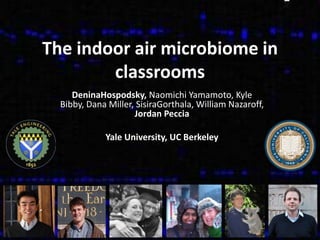Peccia qiime vamps_workshop
- 1. The indoor air microbiome in classrooms DeninaHospodsky, Naomichi Yamamoto, Kyle Bibby, Dana Miller, SisiraGorthala, William Nazaroff, Jordan Peccia Yale University, UC Berkeley
- 2. Background  How does the human occupant shape the indoor air microbiome?  Classrooms  Defined times of occupancy and vacancy  Constant numbers of occupants  Public places  Children, a susceptible population, spend considerable amount of time in classrooms
- 3. Goals: Toidentifysources and calculate emission rates of indoor (bio)aerosols  Objectives:  To combine biomolecular techniques and particle modeling to assess the influence of the human occupant on shaping the indoor air microbiome  To describe and model these two processes for biological and total particles  To identify sources of bacteria and fungi in indoor air using phylogentic information  Understand how building design and operation influences the indoor air microbiome shedding resuspension resuspension
- 4. Eleven sampling sites- classrooms, 3-4 days of continuous occupied and unoccupied sampling each Arhus Berlin Lyngby New Haven Lanzhou 1 Salinas Lanzhou 2
- 5. Study design  Floor dust as well as indoor and outdoor air collection during times of occupancy and vacancy using multistage Andersen cascade impactor in eleven classrooms  Quantitative data from qPCR for all samples  Bacterial and fungal emission rate calculations  Fungal ITS region from (almost) all air and dust samples  Bacterial 16S region for floor dust and occupied air samples from eleven sampling sites
- 6. OccIn Occ out UO in UO out Floor Floor Floor Floor Location (Air) (Air) (Air) (Air) 1 2 3 4 Salinas New Haven 1 New Haven 2 New Haven 3 Arhus Berlin Copenhagen Lanzhou 1 summer Lanzhou 2 winter Lanzhou 1 summer Lanzhou 2 winter Bacteria 16S Fungi ITS only Bacteria 16S only No sample and Fungi ITS
- 7. Study design “metadata”  Air temperature (minute)  Humidity of air (minute)  Particle mass and particle number concentration (all time averaged and per minute)  Bacterial and fungal number concentrations in air and on dust (all time averaged)  # of occupants and their activity rate (minute and time averaged per day)  CO2 concentration and air exchange rate (minute and time averaged per day)  Particle, bacterial, and fungal emission rate (all time averaged) Time scale 1min 1hour 1day 2days 3days 4days
- 8. Data and metadata sharing  Previous sequencing data is available on MG RAST (and via MG RAST on MoBeDac)  metadata documentedin SI or text of publications.  New sequencing data will be submitted to Qiime DB and MG RAST including metadata  No human subjects restrictions
- 9. Sequence data analysis Study needs:  Easy access to sequence data from other groups  Toolsets that allow graphical and analytical comparison of samples from our and other groups Costello et al, Science 2009 Lauber et al, AEM 2009
- 10. What do you hope to get out of the QIIME/VAMPS workshop? 1. Data deposition  Clear guidelines about where to deposit sequencing data when publication date is nearing (MoBeDac? QIIME DB? MG RAST?)  Convenient data deposition with and without “metadata” templates 2. Share sequence data with others  Easy access to published sequencing data of other groups, especially within Sloan  Access to raw data and processed data  Clear communication on how raw sequence data was processed 3. Effective data pooling when sequence regions do not overlap  Alignment tools for 16S and ITS region  Enhanced tools for ITS sequences
- 11. Thank you!
Editor's Notes
- #2: Slight change in title. We are not working on microbes and fungi in the indoor environment, instead the working title for today is THE INDOOR AIR MICROBIOME IN CLASSROOMS
- #7: ~200 air and dust libraries for fungi~120 air and dust libraries for bacteria
- #11: What to do with the dataHow to get access to other pplssequencesHow to use alignment tools for ITS and 16STools for ITS beta diversity











